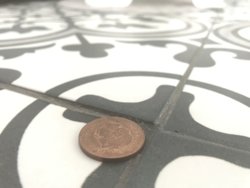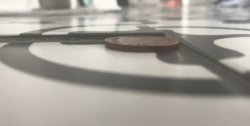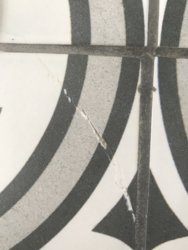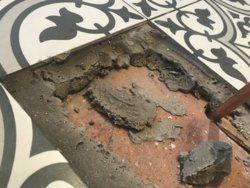Install the app
how_to_install_app_on_ios
follow_along_with_video_below_to_see_how_to_install_our_site_as_web_app

Note: this_feature_currently_may_not_be_available_in_some_browsers
You are using an out of date browser. It may not display this or other websites correctly.
You should upgrade or use an alternative browser.
You should upgrade or use an alternative browser.
Search the forum,
 I suppose that's why our experience in dealing with crap helps us establish Good reputations were we can more or less name our price within reason.
I suppose that's why our experience in dealing with crap helps us establish Good reputations were we can more or less name our price within reason.
Then again if it's too bad and other trades are required then so be it
More like ploughed fields Lee
Thankyou. I don’t think it’s been spot fixed, I remember them laying it and the whole floor was covered in stuff I think? That last picture is before they cut the tile for round the radiator pipes.
Could the fact it’s been fixed to ply have caused the crack?
Does that lippage look like it conforms to industry standards? Does any of it conform to industry standards?!
Discuss Tiling Standards in the Tilers' Talk - All Other Countries area at TilersForums.com.
L
LM
I have to deal with clark of works a lot and the above is exactly right, to simplify it if a pound coin which is 3mm can fit anywhere under a two metre straight edge anywhere on the substrate then the substrate is out of tolerence and a quick tip is to tape a pound coin to both edges of a 2 metre straight edge an use two pound coins on the floorPut a 2m long straight edge anywhere on the plasterboard and if there is any gap greater than 3mm between the straight edge and the board then it is not flat enough to tile.
On the tiled wall do the same test using a 2m straight edge with 3mm feet each end. If the gap between this and the tiles exceeds 6mm or the straight edge touches the tiling then the tiling does not meet BS.
This is based on my memory of reading BS5385 a while ago (I no longer have an up to date copy).
The same tests apply for the flatness of a floor substrate and floor tiling.
On a large floor the surface should also be flat within +/-15mm of the datum or as per the architects specified tolerance. I don't know the equivalent wall building tolerance.
L
LM
Lol, but that's what comes with the territory with some private jobsI'm a tiler, not a plasterer.
Then again if it's too bad and other trades are required then so be it
It seems to be the norm these days , and when you tell the client you need a couple of Xtra bags to level out walls etc , they Moan n groan !
Id a small bathroom floor today that was 1.9 m long and was out of level by 12mm ! New floor
Id a small bathroom floor today that was 1.9 m long and was out of level by 12mm ! New floor
F
Flintstone
It depends how involved you want to get, I normally look at a job before I actually start it, If it needs some work then I tell them to get it sorted. If I sub to someone then it's sorted before I turn up. I don't do rip outs because it's a mucky horrible job that I don't need!
L
Lee daykin
hi., first time on here,
But thought I’d give it a go.!
I’m trying to find clarification as to who is responsible for tiling to floors within nhbc standards on site.
We have major issues with uneven floors/screeds.
We have the groundworkers insisting they are laid tolerance, and we have our 3mm at each end of a 2m straight edge tolerance when tiling.
There is a grey are In between the two., as to who is responsible to Make the screed flat to tile to., and indeed whether tiles should be laid to level., or laid to flat.
The screeds are allowed a tolerance of 25 mm out of level over 6 m., which begs the question if we lay level to that maximum tolerance, who is responsible for extra costs involved.
This way also throws up issues at doorways if one end of the house is 25mm higher than the other.
Any bonefide nhbc info would be greatly accepted!!
Thanks lee
But thought I’d give it a go.!
I’m trying to find clarification as to who is responsible for tiling to floors within nhbc standards on site.
We have major issues with uneven floors/screeds.
We have the groundworkers insisting they are laid tolerance, and we have our 3mm at each end of a 2m straight edge tolerance when tiling.
There is a grey are In between the two., as to who is responsible to Make the screed flat to tile to., and indeed whether tiles should be laid to level., or laid to flat.
The screeds are allowed a tolerance of 25 mm out of level over 6 m., which begs the question if we lay level to that maximum tolerance, who is responsible for extra costs involved.
This way also throws up issues at doorways if one end of the house is 25mm higher than the other.
Any bonefide nhbc info would be greatly accepted!!
Thanks lee
L
LM
The builder is supposed to provide you with a floor fit for tiling, within standards. If it’s not then you should ask him to correct it by either grinding down high spots or levelling low points or in most cases both. If he doesn’t want to do it then he should pay you to do it. If not then walk imo. Begin as you mean to go on, if you start tiling sub standard screeds he’ll expect you to do the same on every other floor.
L
Lee daykin
Hi lee thanks for your reply.
Generally the builders pay us to level the floors. Which we do with a 3m straight Edge and staff it off of the highest points, filling in the dips. Then tile to our 2m +\- 3mm tolerance
The argument now is that we do this to flat and not level. If we went to level, we could have steps at doorways., unless we level the entire house which is obviously not an option.
I guess what I’m looking for is clarification over the level or flat debate.! The is issue on this occasion is that they now want the hallway tiled after having tiled the kitchen to flat., the hallway has a hump
In it, and they’re trying to put it on us that if the floor was tiled to level the jump would not be an issue.
However there would have been a step at the doorway originally. Hope this all makes sense!
Thanks
Generally the builders pay us to level the floors. Which we do with a 3m straight Edge and staff it off of the highest points, filling in the dips. Then tile to our 2m +\- 3mm tolerance
The argument now is that we do this to flat and not level. If we went to level, we could have steps at doorways., unless we level the entire house which is obviously not an option.
I guess what I’m looking for is clarification over the level or flat debate.! The is issue on this occasion is that they now want the hallway tiled after having tiled the kitchen to flat., the hallway has a hump
In it, and they’re trying to put it on us that if the floor was tiled to level the jump would not be an issue.
However there would have been a step at the doorway originally. Hope this all makes sense!
Thanks
L
LM
When the screed is installed it has three datums that it has to meet which should all be the same, the exterior door sills, the bottom of the interior door frames and the bottom of the stairs. If the screed is meeting all these points then it can't be too far out and if it isn't then there's going to be major issues. If the floor is so far out in the hall the front door probably wont open and the bottom riser height of the stair will be out of acceptable limits for building control. If it's that bad have them take it out and replace it.
are you talking screed or concrete.
Surely levelling the floor is a contractual issue.
As you rightly say flat and level are different things. I would think flat is more important than level if there is only 25mm fall over 6m.
The screed standards and the concrete standards are generally not very explicit about specific requirements for flatness or levelness. But the contractor will presumably have a specification for the concrete and you will have a specification for the tiling requirements which should be explicit.
Surely levelling the floor is a contractual issue.
As you rightly say flat and level are different things. I would think flat is more important than level if there is only 25mm fall over 6m.
The screed standards and the concrete standards are generally not very explicit about specific requirements for flatness or levelness. But the contractor will presumably have a specification for the concrete and you will have a specification for the tiling requirements which should be explicit.
L
Lee daykin
Yes these are supposed powerfloated screeds., for bovis, Redrow.. laid at slab before walls erected.
it’s a common issue where we are., the nhbc spec is very vague regarding tiling.. (as always).
Trouble is they’re getting ground workers to lay Screeds!
it’s a common issue where we are., the nhbc spec is very vague regarding tiling.. (as always).
Trouble is they’re getting ground workers to lay Screeds!
L
LM
If I were you and you didn’t want to ditch the job then I’d just charge for my pain. I’m well experienced at dealing with pathetic floors (@John Benton) I’ll do what I have to so long as it makes financial sense. Sooner or later the QS will realise that it’s cheaper to employ professional Screeder’s to do the job properly than to pay you to sort out bad screeds.
If I were you and you didn’t want to ditch the job then I’d just charge for my pain. I’m well experienced at dealing with pathetic floors (@John Benton) I’ll do what I have to so long as it makes financial sense. Sooner or later the QS will realise that it’s cheaper to employ professional Screeder’s to do the job properly than to pay you to sort out bad screeds.
More like ploughed fields Lee
L
Lee daykin
Hi gents..
So after a day of emails and phone calls for future reference.
I have it from the horses mouth that is our local nhbc inspector..
screeds are allowed a tolerance of 25mm over 6m, or 4mm per m.
As w knew, and the tolerance for tiling is -/+ 3mm over a 2m srraight edge.
Straight edge being the key word. Not level.
So if the kitchen for example is laid to flat, and then the hallway or any adjoing Room needs tiling as an afterthought., any undulations in that are are treated as a separate entity, and need grinding down/levelling to suit..
thanks for all the reply’s., so kind as someone else is covering the costs then all good.!!
Cheers lee
So after a day of emails and phone calls for future reference.
I have it from the horses mouth that is our local nhbc inspector..
screeds are allowed a tolerance of 25mm over 6m, or 4mm per m.
As w knew, and the tolerance for tiling is -/+ 3mm over a 2m srraight edge.
Straight edge being the key word. Not level.
So if the kitchen for example is laid to flat, and then the hallway or any adjoing Room needs tiling as an afterthought., any undulations in that are are treated as a separate entity, and need grinding down/levelling to suit..
thanks for all the reply’s., so kind as someone else is covering the costs then all good.!!
Cheers lee
J
Julia84
I posted yesterday about the poor job that has been made of our shower wall tiles. Since then I’ve become something of an expert on tiling (haha) and have another query regarding our floor tiles. The lippage seems excessive in areas. Photos of the worst area below. Is that acceptable?
Further more this week I’ve found a cracked floor tile that definitely wasn’t there before. No one remembers dropping anything on the floor but it kind of looks like a blunt force from above so I am willing to accept it must be something we’ve done. However, given the poor job elsewhere there’s a slight concern this is due to the way the tiles have been laid?
Bathroom all 7 months old. Will include a picture of when the tiles were being laid.
Thanks!




Further more this week I’ve found a cracked floor tile that definitely wasn’t there before. No one remembers dropping anything on the floor but it kind of looks like a blunt force from above so I am willing to accept it must be something we’ve done. However, given the poor job elsewhere there’s a slight concern this is due to the way the tiles have been laid?
Bathroom all 7 months old. Will include a picture of when the tiles were being laid.
Thanks!




H
hmtiling
I'm afraid it's atrocious. Both in method and finish
I posted yesterday about the poor job that has been made of our shower wall tiles. Since then I’ve become something of an expert on tiling (haha) and have another query regarding our floor tiles. The lippage seems excessive in areas. Photos of the worst area below. Is that acceptable?
Further more this week I’ve found a cracked floor tile that definitely wasn’t there before. No one remembers dropping anything on the floor but it kind of looks like a blunt force from above so I am willing to accept it must be something we’ve done. However, given the poor job elsewhere there’s a slight concern this is due to the way the tiles have been laid?
Bathroom all 7 months old. Will include a picture of when the tiles were being laid.
Thanks!
View attachment 100304 View attachment 100305 View attachment 100306 View attachment 100307
H
hmtiling
Fi
Was it a general builder by chance?
It's been spot fixed and fixed to ply. Should have been overboarded with cement board, levelled then tiled use a notched trowel.Could you elaborate so I can question them when they come round tomorrow?
Was it a general builder by chance?
J
Julia84
By spot fixed do you mean dot and dab? AsFi
It's been spot fixed and fixed to ply. Should have been overboarded with cement board, levelled then tiled use a notched trowel.
Was it a general builder by chance?
Fi
It's been spot fixed and fixed to ply. Should have been overboarded with cement board, levelled then tiled use a notched trowel.
Was it a general builder by chance?
Thankyou. I don’t think it’s been spot fixed, I remember them laying it and the whole floor was covered in stuff I think? That last picture is before they cut the tile for round the radiator pipes.
Could the fact it’s been fixed to ply have caused the crack?
Does that lippage look like it conforms to industry standards? Does any of it conform to industry standards?!
D
Dumbo
Surely the best way to get new houses tiled correctly using to correct preparation materials is for the likes of NHBC not to sign houses off If they have tiles on ply walls . Heavy tiles on skimmed walls etc . Surely the the tta should canvas them explaining risks associated with bad instalation .Or is it NHBC don't care because they don't pay out either
D
Dumbo
They would soon learn to read if guarantee man wasn't signing it off and mortgage man then wouldn't release the money to client who needs it to make stage payment .And you need to remember that most builders cannot read, so the cost of producing picture books that can explain best practise tiling techniques would be very high indeed!
Reply to Tiling Standards in the Tilers' Talk - All Other Countries area at TilersForums.com
Posting a tiling question to the forum? Post in Tilers' Talk if you are unsure which forum to post in. We'll move it if there's a more suitable forum.
